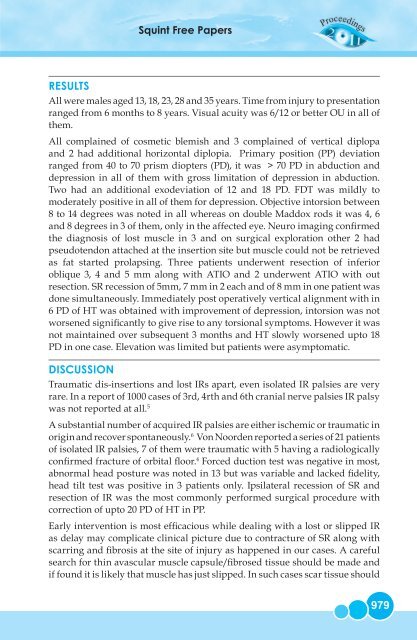Squint Free Papers - aioseducation
Squint Free Papers - aioseducation
Squint Free Papers - aioseducation
Create successful ePaper yourself
Turn your PDF publications into a flip-book with our unique Google optimized e-Paper software.
<strong>Squint</strong> <strong>Free</strong> <strong>Papers</strong><br />
RESULTS<br />
All were males aged 13, 18, 23, 28 and 35 years. Time from injury to presentation<br />
ranged from 6 months to 8 years. Visual acuity was 6/12 or better OU in all of<br />
them.<br />
All complained of cosmetic blemish and 3 complained of vertical diplopa<br />
and 2 had additional horizontal diplopia. Primary position (PP) deviation<br />
ranged from 40 to 70 prism diopters (PD), it was > 70 PD in abduction and<br />
depression in all of them with gross limitation of depression in abduction.<br />
Two had an additional exodeviation of 12 and 18 PD. FDT was mildly to<br />
moderately positive in all of them for depression. Objective intorsion between<br />
8 to 14 degrees was noted in all whereas on double Maddox rods it was 4, 6<br />
and 8 degrees in 3 of them, only in the affected eye. Neuro imaging confirmed<br />
the diagnosis of lost muscle in 3 and on surgical exploration other 2 had<br />
pseudotendon attached at the insertion site but muscle could not be retrieved<br />
as fat started prolapsing. Three patients underwent resection of inferior<br />
oblique 3, 4 and 5 mm along with ATIO and 2 underwent ATIO with out<br />
resection. SR recession of 5mm, 7 mm in 2 each and of 8 mm in one patient was<br />
done simultaneously. Immediately post operatively vertical alignment with in<br />
6 PD of HT was obtained with improvement of depression, intorsion was not<br />
worsened significantly to give rise to any torsional symptoms. However it was<br />
not maintained over subsequent 3 months and HT slowly worsened upto 18<br />
PD in one case. Elevation was limited but patients were asymptomatic.<br />
DISCUSSION<br />
Traumatic dis-insertions and lost IRs apart, even isolated IR palsies are very<br />
rare. In a report of 1000 cases of 3rd, 4rth and 6th cranial nerve palsies IR palsy<br />
was not reported at all. 5<br />
A substantial number of acquired IR palsies are either ischemic or traumatic in<br />
origin and recover spontaneously. 6 Von Noorden reported a series of 21 patients<br />
of isolated IR palsies, 7 of them were traumatic with 5 having a radiologically<br />
confirmed fracture of orbital floor. 4 Forced duction test was negative in most,<br />
abnormal head posture was noted in 13 but was variable and lacked fidelity,<br />
head tilt test was positive in 3 patients only. Ipsilateral recession of SR and<br />
resection of IR was the most commonly performed surgical procedure with<br />
correction of upto 20 PD of HT in PP.<br />
Early intervention is most efficacious while dealing with a lost or slipped IR<br />
as delay may complicate clinical picture due to contracture of SR along with<br />
scarring and fibrosis at the site of injury as happened in our cases. A careful<br />
search for thin avascular muscle capsule/fibrosed tissue should be made and<br />
if found it is likely that muscle has just slipped. In such cases scar tissue should<br />
979

















